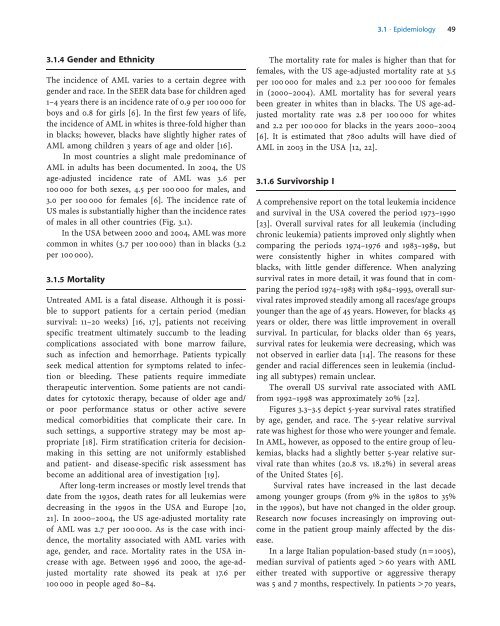Acute Leukemias - Republican Scientific Medical Library
Acute Leukemias - Republican Scientific Medical Library
Acute Leukemias - Republican Scientific Medical Library
Create successful ePaper yourself
Turn your PDF publications into a flip-book with our unique Google optimized e-Paper software.
a 3.1 · Epidemiology 49<br />
3.1.4 Gender and Ethnicity<br />
The incidence of AML varies to a certain degree with<br />
gender and race. In the SEER data base for children aged<br />
1–4 years there is an incidence rate of 0.9 per 100 000 for<br />
boys and 0.8 for girls [6]. In the first few years of life,<br />
the incidence of AML in whites is three-fold higher than<br />
in blacks; however, blacks have slightly higher rates of<br />
AML among children 3 years of age and older [16].<br />
In most countries a slight male predominance of<br />
AML in adults has been documented. In 2004, the US<br />
age-adjusted incidence rate of AML was 3.6 per<br />
100 000 for both sexes, 4.5 per 100 000 for males, and<br />
3.0 per 100 000 for females [6]. The incidence rate of<br />
US males is substantially higher than the incidence rates<br />
of males in all other countries (Fig. 3.1).<br />
In the USA between 2000 and 2004, AML was more<br />
common in whites (3.7 per 100 000) than in blacks (3.2<br />
per 100 000).<br />
3.1.5 Mortality<br />
Untreated AML is a fatal disease. Although it is possible<br />
to support patients for a certain period (median<br />
survival: 11–20 weeks) [16, 17], patients not receiving<br />
specific treatment ultimately succumb to the leading<br />
complications associated with bone marrow failure,<br />
such as infection and hemorrhage. Patients typically<br />
seek medical attention for symptoms related to infection<br />
or bleeding. These patients require immediate<br />
therapeutic intervention. Some patients are not candidates<br />
for cytotoxic therapy, because of older age and/<br />
or poor performance status or other active severe<br />
medical comorbidities that complicate their care. In<br />
such settings, a supportive strategy may be most appropriate<br />
[18]. Firm stratification criteria for decisionmaking<br />
in this setting are not uniformly established<br />
and patient- and disease-specific risk assessment has<br />
become an additional area of investigation [19].<br />
After long-term increases or mostly level trends that<br />
date from the 1930s, death rates for all leukemias were<br />
decreasing in the 1990s in the USA and Europe [20,<br />
21]. In 2000–2004, the US age-adjusted mortality rate<br />
of AML was 2.7 per 100 000. As is the case with incidence,<br />
the mortality associated with AML varies with<br />
age, gender, and race. Mortality rates in the USA increase<br />
with age. Between 1996 and 2000, the age-adjusted<br />
mortality rate showed its peak at 17.6 per<br />
100 000 in people aged 80–84.<br />
The mortality rate for males is higher than that for<br />
females, with the US age-adjusted mortality rate at 3.5<br />
per 100 000 for males and 2.2 per 100 000 for females<br />
in (2000–2004). AML mortality has for several years<br />
been greater in whites than in blacks. The US age-adjusted<br />
mortality rate was 2.8 per 100 000 for whites<br />
and 2.2 per 100 000 for blacks in the years 2000–2004<br />
[6]. It is estimated that 7800 adults will have died of<br />
AML in 2003 in the USA [12, 22].<br />
3.1.6 Survivorship I<br />
A comprehensive report on the total leukemia incidence<br />
and survival in the USA covered the period 1973–1990<br />
[23]. Overall survival rates for all leukemia (including<br />
chronic leukemia) patients improved only slightly when<br />
comparing the periods 1974–1976 and 1983–1989, but<br />
were consistently higher in whites compared with<br />
blacks, with little gender difference. When analyzing<br />
survival rates in more detail, it was found that in comparing<br />
the period 1974–1983 with 1984–1993, overall survival<br />
rates improved steadily among all races/age groups<br />
younger than the age of 45 years. However, for blacks 45<br />
years or older, there was little improvement in overall<br />
survival. In particular, for blacks older than 65 years,<br />
survival rates for leukemia were decreasing, which was<br />
not observed in earlier data [14]. The reasons for these<br />
gender and racial differences seen in leukemia (including<br />
all subtypes) remain unclear.<br />
The overall US survival rate associated with AML<br />
from 1992–1998 was approximately 20% [22].<br />
Figures 3.3–3.5 depict 5-year survival rates stratified<br />
by age, gender, and race. The 5-year relative survival<br />
rate was highest for those who were younger and female.<br />
In AML, however, as opposed to the entire group of leukemias,<br />
blacks had a slightly better 5-year relative survival<br />
rate than whites (20.8 vs. 18.2%) in several areas<br />
of the United States [6].<br />
Survival rates have increased in the last decade<br />
among younger groups (from 9% in the 1980s to 35%<br />
in the 1990s), but have not changed in the older group.<br />
Research now focuses increasingly on improving outcome<br />
in the patient group mainly affected by the disease.<br />
In a large Italian population-based study (n = 1005),<br />
median survival of patients aged > 60 years with AML<br />
either treated with supportive or aggressive therapy<br />
was 5 and 7 months, respectively. In patients > 70 years,
















